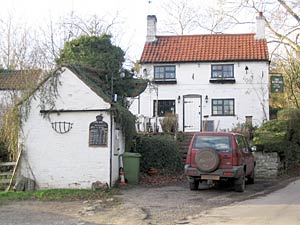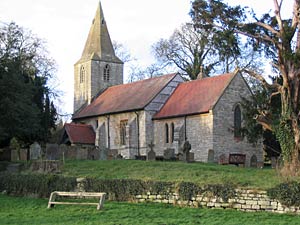< Previous | Contents | Next >
The Thankful Village
MAPLEBECK. It is one of the Thankful Villages, with a grateful pride it shares with two other villages in the county and with only 30 others in all England. It sent its share of men to the war and they came back. This little group of homes at the foot of a hill, hidden from the world among trees and orchards, gave two of its sons to the war; both came through.

The Beehive Inn, Maplebeck, in 2005.
One was William Henfrey, a farmer's son who joined up in 1914, went through the war unscathed, and is now a village innkeeper. The other was Reuben Percy Whitworth, who left his farming and his widowed mother in 1916 and went to France. He was wounded twice. The first time the bullet hit his cigarette case, which saved him; the second time he was wounded by shrapnel in the German advance of 1918 and left lying on the battlefield for five days, when the Germans picked him up and took him prisoner. He came home to do a little farming and keep the cottage inn, one of the smallest inns we have seen. In this little place, with low ceilings and great beams, the most interesting thing we saw was the bullet that nearly cost him his life. There is a written roll of honour in the church on which are the two names, with the names of other men who did not go from here; but there is no peace memorial.

Maplebeck church in 2005.
Picturesque with its grey walls and red roofs, the pleasing church is high above the road in a setting of fine beeches, limes, sycamores, and chestnuts, with a splendid old yew 20 feet round its hollow trunk. On the slope toward the old vicarage are two great cedars.
It is a medieval church restored. From the 14th century come the tower with its low spire, and the nave arcade. The 13th century chancel has two of its original lancets, and a 13th century doorway is in the aisle. The head of an aisle window is formed by part of an ancient coffin stone, and part of another is built into the aisle wall. Here, too, are four small pillars set in the wall, believed to have supported the 13th century stone altar. The fine old font bowl has been partly made new.
Most of the woodwork is Jacobean—the altar rails, the canopied pulpit, the neat oak benches with many of the seats renewed, and the chancel screen with balustrades to which has been added a 15th century beam. Fine 14th century timbers, grey with age, support the roof of the porch, and on one of the beams a wooden face near the door has been greeting all who have come this way for 600 years.
